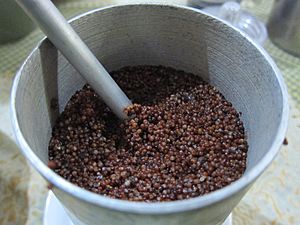Sikkimese cuisine facts for kids
The cuisine of Sikkim is super interesting! Sikkim is a beautiful state in northeastern India. Here, rice is the main food people eat every day. A big part of their food culture involves fermented foods. This means foods that have been changed by tiny living things like bacteria or yeast, which helps preserve them and gives them unique flavors.
Sikkim shares its borders with Nepal and Tibet, so their food has been greatly influenced by Nepalese cuisine and Tibetan cuisine. You'll find many restaurants in Sikkim serving delicious Nepalese dishes. This mix of different food styles makes Sikkimese cuisine very special and tasty!
How Food is Grown in Sikkim

The way food is grown in Sikkim really shapes what people eat. Sikkim is a mountainous region, so there isn't a lot of flat land for farming. Because of this, farmers use a special method called terrace farming. Imagine giant steps cut into the side of a mountain – that's what terraces look like! This helps them grow crops like rice on slopes.
Besides rice, farmers also grow other grains like wheat, maize (corn), barley, and millet. You'll also find lots of potatoes, ginger, sweet oranges, tea, and cardamom. Sikkim is actually the biggest producer of cardamom in India, growing about 4,200 tons every year! Common vegetables grown here include tomatoes, broccoli, and a squash called iskus.
Even though people in Sikkim eat dairy products, meat, and eggs, raising animals is not the main part of farming. Farmers raise Cattle, sheep, goats, pigs, and yaks. About 11.7% of people in rural Sikkim are vegetarian.
In 2016, Sikkim made history by becoming India's first "organic state." This means all its farms use sustainable farming practices, avoiding harmful chemicals. This is great for the environment and for healthy food!
Amazing Fermented Foods

Fermented foods are a huge part of what people eat in Sikkim. They make up about 12.6% of all the food consumed! It's so common that most Sikkimese families make their own fermented foods at home. They usually buy only a few things like chhurpi (a type of cheese) and marchaa (a special starter for fermentation) from markets.
People also make many fermented alcoholic drinks. They use marchaa with grains like millet, rice, or maize. First, the grain is washed and cooked. Then, it's mixed with marchaa and put into a sealed pot for a day or two. After that, it ferments for another 2 to 8 days, turning into a drink!
Some traditional fermented foods you might find are kinema, gundruk, sinki, and maseura. Popular fermented drinks include chyang, tongba, raksi, and kodo ko jaanr.
Popular Dishes to Try
Sikkimese meals often follow a pattern: rice, pulses (like lentils), curry, and pickle. Here are some famous dishes:
- Chhurpi: This is a traditional Nepalese cheese made from buttermilk. There are two kinds: a soft one eaten as a side dish, and a hard one that people chew on like candy!
- Dal bhat: This is a very common meal of boiled rice and pulses (like lentils). It's often cooked with onions, garlic, ginger, chili, tomatoes, or tamarind. It's usually served with a vegetable curry called tarkari.
- Dhindo: A Nepalese dish made by slowly adding flour to boiling water until it becomes a thick paste.
- Gundruk: This is a Nepalese fermented leafy green vegetable. Farmers take extra mustard, radish, and cauliflower leaves, shred them, and then seal them in an earthenware pot in a warm place to ferment.
- Kinema: A Nepalese fermented soybean dish. It's traditionally eaten in a soup with rice, but sometimes it's served as a side dish with rice or bread.
- Momo: These are steamed dumplings that are super popular across the Himalayas! They are usually filled with minced meat or vegetables like chayote or cabbage inside a dough wrapper. People eat them with vegetable or meat soup and a tomato pickle.
- Phagshapa: A Nepalese dish with strips of pork fat stewed with radishes and dried chillies. It's hearty and flavorful.
- Sel roti: A Nepalese rice bread that is shaped like a ring and tastes sweet. It's often made during the Dashain and Tihar festivals.
- Sinki: Another Nepalese fermented vegetable. This one is made by shredding radish roots and storing them in a sealed hole in the ground for about a month.
- Shabhaley: A Tibetan bread that is stuffed with seasoned beef and cabbage. It's then fried or baked.
- Thukpa: A warm and comforting Tibetan noodle soup. It can be made with vegetables or meat.

